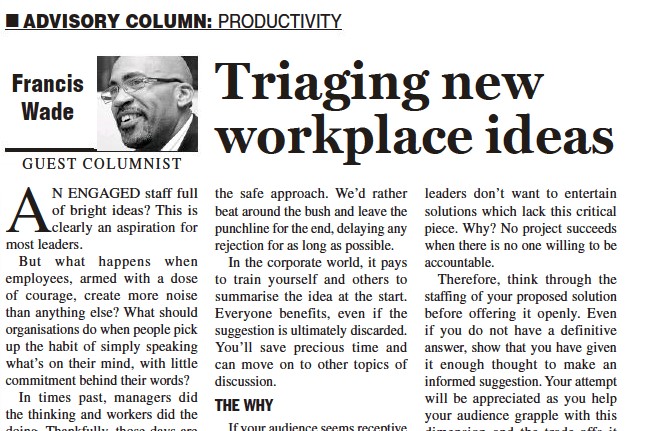An engaged staff full of bright ideas? This is clearly an aspiration for most leaders. But what happens when employees, armed with a dose of courage, create more noise than anything else? What should organizations do when people pick up the habit of simply speaking what’s on their mind, with little commitment behind their words?
In times past, managers did the thinking and workers did the doing. Thankfully, those days are long gone and staff expect their input to be taken seriously. Their engagement is critical.
However, executives with open-door policies can spend all day at the mercy of those who think they have good ideas. Indulge too often, and they fall into inefficiency, even with the best of intentions. While their openness is a fine start, it’s not enough.
According to Michael Stelzner from the Social Media Marketing Show, you must learn to follow three counter-intuitive steps when you sell your suggestions.
- The What
The higher up you go in an organization, the greater the need to begin any proposal with the headline or solution – “the What”. Why? Leaders are time and attention constrained. Their people are required to get to the point.
Journalists have a name for it: “burying the lead.” It refers to a British-inspired tradition of using polite banter before getting to the bottom-line. Unfortunately, it’s a deadly communication sin in today’s world of ongoing distractions.
As such, reporters are taught to unlearn this practice because it loses the reader’s attention. The lead (i.e. the main point) comes first, and the explanatory details after.
However, in everyday life, this takes courage. Most of us prefer the safe approach. We’d rather beat around the bush and leave the punchline for the end, delaying any rejection for as long as possible.
In the corporate world, it pays to train yourself and others to summarize the idea at the start. Everyone benefits, even if the suggestion is ultimately discarded. You’ll save precious time and can move on to other topics of discussion.
- The Why
If your audience seems receptive to “The What”, shift gears to explain the reasons your idea is important.
You may describe the past, present and future of the problem. Why has it not been cleared up? Why is this the ideal moment to make a public commitment to deal with the issue? What is the cost to the organization if the obstacle is allowed to continue? What if the challenge is never addressed at all?
One way to answer these questions is in the form of a story in which the members of your audience take the role of protagonists. Their tale begins with the normal, everyday situation where everything is working as it should. Then, it’s interrupted by a failure of some kind that introduces pain. Finally, the saga ends with your suggestion for taking action.
In this finishing step, your solution addresses a range of functional, emotional and social gaps which the breakdown has produced. They amplify the impact of the breach in order to generate real-time attention and commitment.
- The Who
If the heads are nodding at this point, you’re ready for the element that most employees fail to address. Who exactly will implement the initiative?
The answer to this question separates the talkers from the implementers. The fact is, most leaders don’t want to entertain solutions which lack this critical piece. Why? No project succeeds when there is no-one willing to be accountable.
Therefore, think through the staffing of your proposed solution before offering it openly. Even if you do not have a definitive answer, show that you have given it enough thought to make an informed suggestion. Your attempt will be appreciated as you help your audience grapple with this dimension and the trade-offs it demands.
Finally, resist the temptation to get caught up in the question of “How should this be implemented?” Usually, this moment is neither the time nor the place to delve into that level of detail. Why? The subject-matter experts are probably not in attendance, accountable individuals have not been assigned and a decision to proceed hangs in the balance.
Instead, trust the project team to figure out “The How” after careful study, once they have consulted appropriate stakeholders.
In other words, don’t allow uninformed (but well-meaning) leaders to indulge in commitment-free, speculative conversations. While they are comfortable and even enjoyable, they are out of place and waste everyone’s time.
In summary, follow the What, Why and Who script, and delay the How discussion. If you discipline yourself as an organization to stick to this formula, you’ll see better ideas bubbling up to the right places from your staff.

